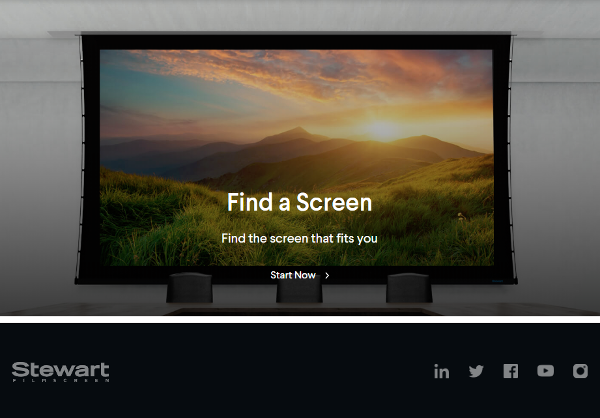Stewart Filmscreen Streamlines Screen Selection

The heart of the site is a Find a Screen section that uses simple graphics and intuitive options to guide you through the selection process, starting with choosing a screen type (retractable, fixed frame, rigid), mounting method (wall, above ceiling, below ceiling, floor, aperture), and projector type (front or rear).
You are then prompted to select one of four aspect ratios and screen dimensions, with hundreds of diagonal sizes between 80 and 707 inches presented in 1-inch increments via a drop-down menu. The next step is to define how much control you have over lighting in your room and select one of three options: full control, partial control, or no control.
From there you can specify whether you want an acoustically transparent screen, one with an opaque layer that eliminates light bleed, or a screen designed for 3D viewing; in each case you can drill-down by clicking “learn more.”
Once all selections are made, you click “show me my screen and material options” and Stewart recommends options, each with “learn more” buttons. You also have the option of downloading the recommendations.
The selection process applies to preconfigured or custom-made screens from one of Stewart’s 35 product families. When you select a screen, you are taken to a multi-tab product page with full details and a photo gallery showing real-life installations; you also have the option of printing a brochure with technical information, fabric options, and — for the first time — suggested retail price.
The screen finder also includes a new configurator tool (now in beta) with CAD drawing and quote capabilities to expedite the design process for integrators.
In addition simplifying the screen-selection process, Stewart has created more intuitive names for many of its popular screens to make it easier to understand differences between models.
"Not all screens are created equal, and no two environments are the same,” said Mary Stewart, owner and CEO of Stewart Filmscreen. “That is why we offer so many options, why our process is application-driven, and why every product is custom-made.
"All these tools now make it possible to quickly see and select the perfect screen solution for any application while also delivering the highest attention to image uniformity, color accuracy, and resolution preservation of even the most advanced projectors on the market."
For more information, visit stewartfilmscreen.com.
























































